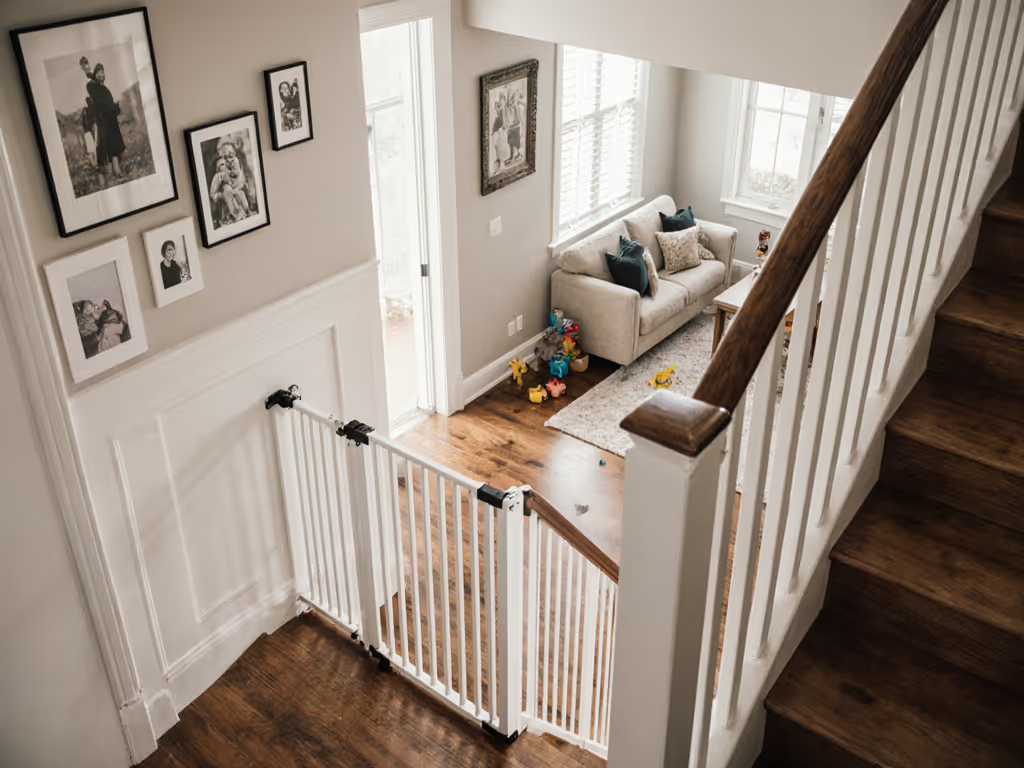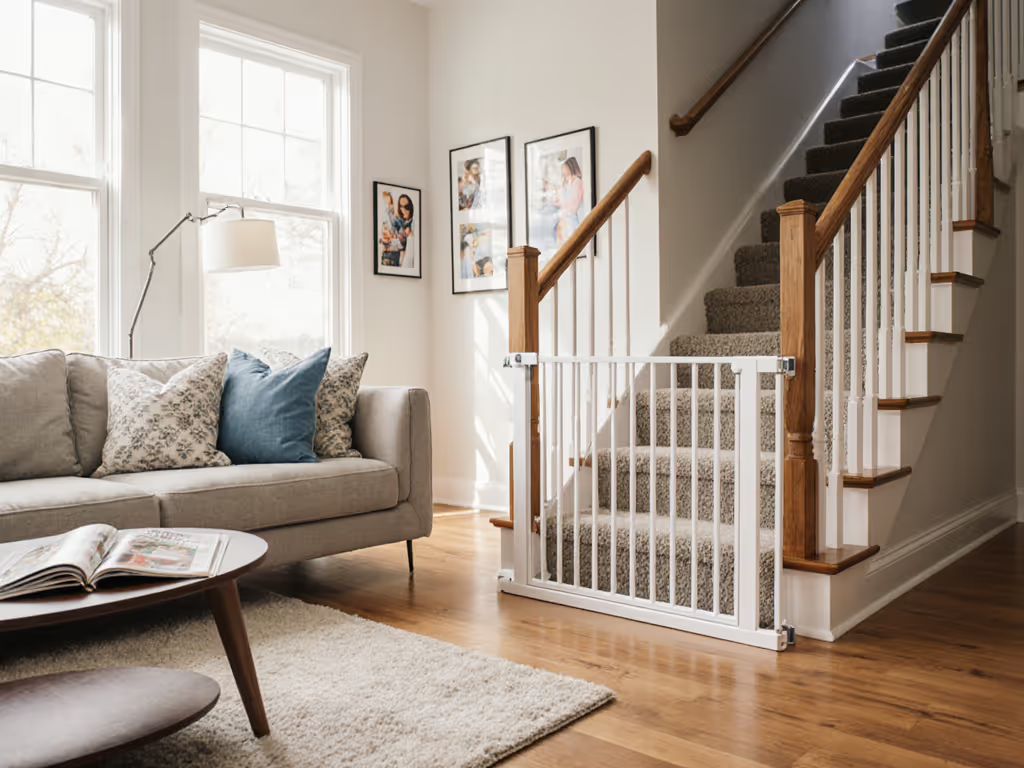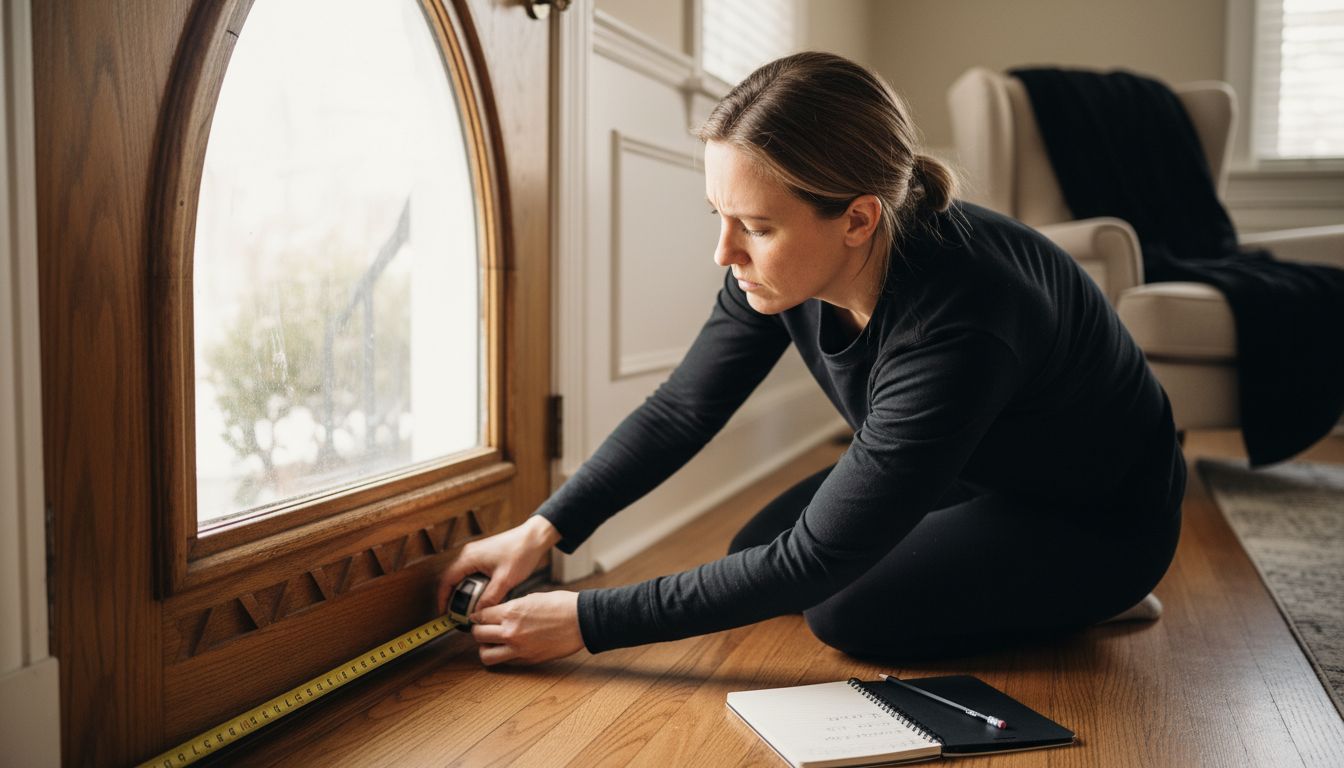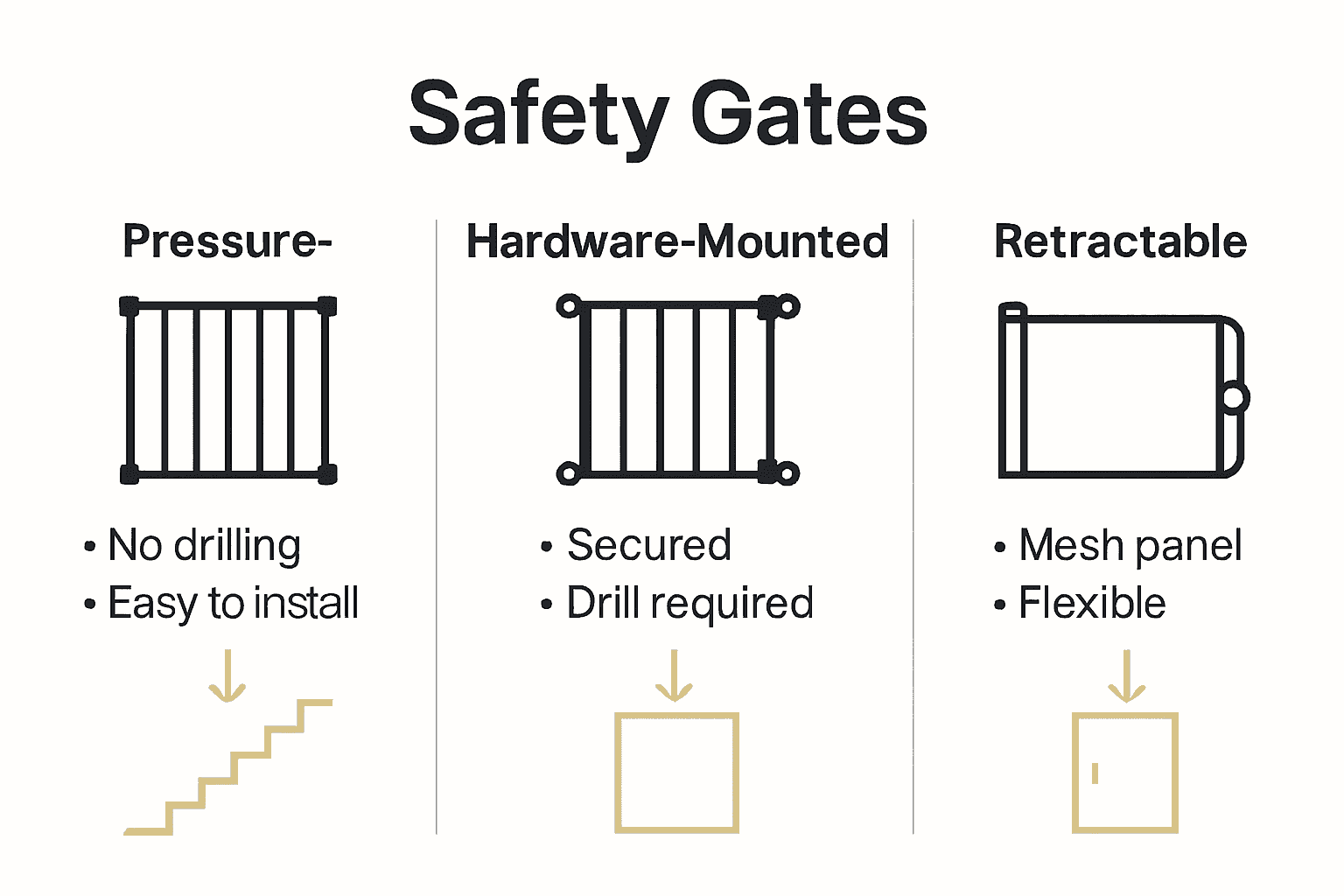
How to Choose Safety Gate for Your Home: Step-by-Step Guide

Over 80 percent of childhood injuries at home happen in areas like stairs, kitchens, and hallways. When little ones start to explore, even familiar spaces can become risky in seconds. Taking time to assess your home's layout and safety needs now sets the foundation for protection that actually works. This guide shows you how thoughtful planning and the right tools help you keep every corner safe for your family.
Quick Summary
| Key Point | Explanation |
|---|---|
| 1. Assess your safety needs first | Thoroughly evaluate your home's layout and hazard zones before selecting a safety gate. |
| 2. Measure spaces accurately | Take precise measurements of openings to ensure a perfect fit for your safety gate. |
| 3. Choose suitable gate types | Understand different safety gate mechanisms and select the right one based on the installation environment. |
| 4. Check materials and certifications | Ensure the gate’s materials are durable and check for safety certifications to guarantee child safety. |
| 5. Conduct a thorough installation check | After mounting, test the gate for stability and functionality to ensure it effectively protects your child. |
Step 1: Assess Safety Needs and Home Layout
When selecting a safety gate for your home, the first critical step is thoroughly assessing your specific safety needs and understanding your home's unique layout. Think of this process like creating a personalized safety blueprint that matches your family's specific requirements and living space characteristics.
Start by walking through each area of your home with a critical eye. Identify potential hazard zones where children or pets might access dangerous spaces such as staircases, kitchen areas, home offices, or rooms with fragile items. Measure the width of doorways, hallways, and openings where you plan to install gates measuring both the top and bottom width at multiple points. Not all openings are perfectly rectangular - some might have baseboards, uneven walls, or slight variations that impact gate installation. Specifically note areas with irregular shapes or non standard dimensions that could complicate standard gate fitting.
Pro tip: Create a simple hand drawn map or digital sketch of your home highlighting all potential gate locations. Include precise measurements for each opening and note any special characteristics like wall material, doorframe design, or potential mounting challenges. This preparation will save you significant time and frustration when actually shopping for and installing safety gates.

With your home layout assessment complete, you are now ready to move on to researching specific gate types that will seamlessly integrate into your identified safety zones.
Step 2: Measure Spaces and Identify Gate Locations
Measuring your spaces accurately is the cornerstone of selecting the right safety gate. Your goal is to capture precise dimensions that will ensure a perfect and secure fit for every potential gate location in your home.
Start by gathering essential tools: a metal tape measure with a lock feature, a notepad, and a pencil. Measure each potential gate location multiple times to confirm accuracy. For width measurements, check at the top middle and bottom of the opening since walls are not always perfectly straight. According to safety guidelines from the Abu Dhabi Public Health Center, pay special attention to potential gap risks. Openings should allow gates with bar spacing no wider than 95 mm to prevent children from squeezing through or getting their head entrapped.
For irregularly shaped spaces like staircase landings or oddly configured hallways, use additional techniques. Consider taking digital photos of each area alongside your measurements to create a comprehensive reference. Sketch rough layouts showing exact dimensions and note any obstacles like baseboards molding or uneven surfaces that might complicate gate installation. Remember that precision now saves significant frustration during the actual gate purchasing and mounting process.
With your measurements documented and spaces carefully evaluated, you are now prepared to move forward and explore safety gate options that will perfectly match your home's unique layout.
Step 3: Compare Gate Types and Mechanisms
Understanding the different safety gate types and their unique mechanisms is crucial for selecting the perfect protection solution for your home. Each gate type offers distinct advantages and potential limitations that can significantly impact their effectiveness and suitability for specific spaces.
According to research from Perma Child Safety, there are several primary gate mechanisms to consider. Pressure mounted gates are versatile and easy to install using tension springs that hold the gate between walls or doorframes without requiring permanent hardware. These work well for areas like hallways or between rooms. Hardware mounted gates provide the most secure option by drilling mounting brackets directly into wall surfaces or doorframes making them ideal for high risk areas like staircases. Retractable gates offer a modern alternative with a sliding mechanism that can disappear when not in use giving you flexibility in smaller spaces. Playpens represent another safety option that creates a contained area for younger children.
Pro tip: When comparing gate types always consider the specific environment where you will install the gate. Staircases require hardware mounted gates for maximum stability while temporary barriers between rooms might work perfectly with pressure mounted options. Check the manufacturer specifications carefully and ensure the gate meets safety standards appropriate for your child's age and mobility level. Some gates work better for crawling infants while others are designed for more active toddlers who might attempt to climb or push through barriers.
With a clear understanding of different gate mechanisms and their appropriate uses, you are now ready to select the most suitable safety gate for each specific area of your home.

Step 4: Evaluate Materials and Safety Certifications
Selecting the right safety gate involves more than just measuring and choosing a mechanism. Understanding the materials and safety certifications can make the difference between a reliable protective barrier and a potential risk for your child.
When evaluating materials, consider durability resilience and child safety features. Metal gates typically offer the strongest construction while wooden gates provide aesthetic appeal. Plastic gates can be lightweight and affordable but might not withstand aggressive toddler interactions. According to the Abu Dhabi Public Health Center guidelines look for gates with specific safety requirements. These include mechanisms that require deliberate force to open two separate opening actions and designs without sharp edges or small detachable parts that could pose choking hazards. Certification marks from recognized safety organizations like ASTM International indicate the gate has undergone rigorous testing to meet established child safety standards.
Pro tip: Inspect the gate mechanism closely before purchasing. Test the opening and closing action to ensure it requires intentional adult effort but remains manageable for older children who might need to pass through. Check for smooth edges rounded corners and sturdy construction that can withstand repeated use. Materials should be non toxic easy to clean and resistant to potential impacts from active children. A gate that looks good on paper but fails under real world conditions is not a true safety solution.
With a comprehensive understanding of materials and safety standards you are now equipped to make an informed decision about the most appropriate safety gate for your home environment.
Step 5: Test Fit and Inspect Installation
After carefully selecting your safety gate the final and most critical step is ensuring proper installation. A perfectly chosen gate can become ineffective or even dangerous if not mounted correctly understanding the nuances of fit and installation will help protect your child effectively.
Begin by thoroughly reviewing the manufacturer instructions specific to your gate model. According to the Abu Dhabi Public Health Center guidelines installation must meet precise safety standards. Pressure mounted gates require careful alignment and consistent tension to prevent gaps or potential tipping. Hardware mounted gates demand precise drilling and secure anchoring into wall surfaces. Check that the gate requires deliberate force to open preventing accidental release by children. Verify there are no exposed sharp edges or protruding screws that could cause injury. During installation test the mechanism multiple times ensuring smooth opening and closing actions that feel secure yet manageable for adult use.
Pro tip: After installation perform a comprehensive safety evaluation by applying moderate pressure from different angles to simulate a child pushing or leaning against the gate. The gate should remain firmly in place without wobbling or creating potential escape routes. Consider adding additional mounting hardware or consulting a professional if you encounter any installation challenges or notice even slight instability. Remember that periodic reinspection is key children grow quickly and their ability to test gate boundaries evolves rapidly.
With your safety gate carefully installed and thoroughly tested you have successfully created an important protective barrier in your home environment.
Secure Your Home with Confidence Using Expert Safety Gate Guidance
Choosing the perfect safety gate for your home can feel overwhelming with so many types, measurements, and safety standards to consider. This article highlights the challenge of accurately measuring spaces and selecting gates that truly fit your unique home layout without compromising on safety. It can be frustrating to worry whether the gate will hold firm under pressure or if the materials meet rigorous safety certifications designed to protect your child from harm.
You do not have to navigate this process alone. Visit BabySafetyGates.World where you will find detailed product reviews, easy-to-understand comparison charts, and step-by-step installation advice tailored to busy parents and caregivers. Whether you need durable hardware-mounted gates for staircases or lightweight pressure-mounted options for temporary use, our trusted resources empower you to make smart, confident decisions. Don't wait until safety is compromised. Start exploring practical solutions right now at https://babysafetygates.world and ensure your home becomes a secure space for the little ones you love.
Frequently Asked Questions
How do I assess my safety needs for a safety gate?
Start by evaluating your home layout and identifying hazardous areas, such as staircases or kitchens. Walk through each room, taking note of where to install gates and any irregular wall shapes, so you can measure accurately.
What are the critical measurements to take before buying a safety gate?
To ensure a proper fit, measure the width of each potential gate location at multiple points. Confirm dimensions by measuring the top, middle, and bottom of the opening, as well as accounting for any obstructions like baseboards or uneven walls.
What types of safety gates should I consider for different locations?
Choose the type of safety gate based on the specific environment: pressure-mounted gates are suitable for temporary barriers, while hardware-mounted gates provide maximum stability at staircases. Evaluate the unique needs of each area before making your selection.
What materials should I look for when selecting a safety gate?
Opt for gates made of durable materials like metal for strength, or wood for aesthetics. Ensure that the gate meets safety certifications and has features that prevent accidental openings, like dual-action mechanisms.
How do I properly install a safety gate?
Follow the manufacturer’s instructions closely for the installation process, ensuring all parts are secure. Test the gate after installation by applying moderate pressure to ensure it remains stable and safe for use.
How can I test if my installed safety gate is secure?
After installation, apply pressure from different angles to check for stability. The gate should not wobble or move; if it does, consider reinforcing the installation or consulting a professional for adjustments.




